Differential miRNA Expression Profiling Reveals Correlation of miR125b-5p with Persistent Infection of Japanese Encephalitis Virus
Abstract
1. Introduction
2. Results
2.1. Comparison Analysis of miRNAs in Response to Acute and Persistent JEV Infection
2.2. MicroRNA-125b-5p Is Highly Expressed in BHK-21 Cells Persistently Infected with JEV
2.3. As Soon as the Cells Survived Infection, the High Level of miR-125b-5p Is Readily Detectable
2.4. Transfection of miR-125b-5p Mimic Inhibits Viral Replication
2.5. Targeting Genes of miR-125b-5p
3. Discussion
4. Materials and Methods
4.1. Cells and Viruses
4.2. Plaque Assay
4.3. Establishment of Persistently JEV-Infected BHK-21 Cell Line
4.4. MicroRNA Profiling and Selection of Distinctive miRNAs Using a nCounter miRNA Array System
4.5. RNA Extraction and Northern Blot Analysis of microRNAs
4.6. qPCR
4.7. Transfection of miR-125b-5p and MTT Assay
4.8. Prediction and Cloning of miR-125b-5p Target Sequences
4.9. Western Blot Analysis
4.10. Luciferase Reporter Assay
4.11. Statistical Analysis
Supplementary Materials
Author Contributions
Funding
Institutional Review Board Statement
Informed Consent Statement
Acknowledgments
Conflicts of Interest
References
- Unni, S.K.; Ruzek, D.; Chhatbar, C.; Mishra, R.; Johri, M.K.; Singh, S.K. Japanese encephalitis virus: From genome to infectome. Microbes Infect. 2011, 13, 312–321. [Google Scholar] [CrossRef]
- Banerjee, A.; Tripathi, A. Recent advances in understanding Japanese encephalitis. F1000Research 2019, 8, 1915. [Google Scholar] [CrossRef]
- Randall, R.E.; Griffin, D.E. Within host RNA virus persistence: Mechanisms and consequences. Curr. Opin. Virol. 2017, 23, 35–42. [Google Scholar] [CrossRef]
- Mlera, L.; Melik, W.; Bloom, M.E. The role of viral persistence in flavivirus biology. Pathog. Dis. 2014, 71, 137–163. [Google Scholar] [CrossRef]
- Yoon, S.W.; Lee, S.Y.; Won, S.Y.; Park, S.H.; Park, S.Y.; Jeong, Y.S. Characterization of homologous defective interfering RNA during persistent infection of Vero cells with Japanese encephalitis virus. Mol. Cells 2006, 21, 112–120. [Google Scholar]
- Tsai, K.N.; Tsang, S.F.; Huang, C.H.; Chang, R.Y. Defective interfering RNAs of Japanese encephalitis virus found in mosquito cells and correlation with persistent infection. Virus Res. 2007, 124, 139–150. [Google Scholar] [CrossRef]
- Park, S.Y.; Choi, E.; Jeong, Y.S. Integrative effect of defective interfering RNA accumulation and helper virus attenuation is responsible for the persistent infection of Japanese encephalitis virus in BHK-21 cells. J. Med Virol. 2013, 85, 1990–2000. [Google Scholar] [CrossRef] [PubMed]
- Winter, J.; Jung, S.; Keller, S.; Gregory, R.I.; Diederichs, S. Many roads to maturity: MicroRNA biogenesis pathways and their regulation. Nat. Cell Biol. 2009, 11, 228–234. [Google Scholar] [CrossRef] [PubMed]
- Lima, R.T.; Busacca, S.; Almeida, G.M.; Gaudino, G.; Fennell, D.A.; Vasconcelos, M.H. MicroRNA regulation of core apoptosis pathways in cancer. Eur. J. Cancer 2011, 47, 163–174. [Google Scholar] [CrossRef] [PubMed]
- Zhang, B.; Pan, X.; Cobb, G.P.; Anderson, T.A. microRNAs as oncogenes and tumor suppressors. Dev. Biol. 2007, 302, 1–12. [Google Scholar] [CrossRef] [PubMed]
- Bueno, M.J.; Malumbres, M. MicroRNAs and the cell cycle. Biochim. Biophys. Acta 2011, 1812, 592–601. [Google Scholar] [CrossRef]
- Ivey, K.N.; Srivastava, D. MicroRNAs as regulators of differentiation and cell fate decisions. Cell Stem Cell 2010, 7, 36–41. [Google Scholar] [CrossRef] [PubMed]
- Raisch, J.; Darfeuille-Michaud, A.; Nguyen, H.T. Role of microRNAs in the immune system, inflammation and cancer. World J. Gastroenterol. 2013, 19, 2985–2996. [Google Scholar] [CrossRef] [PubMed]
- Mishra, R.; Kumar, A.; Ingle, H.; Kumar, H. The interplay between viral-derived miRNAs and host immunity during infection. Front. Immunol. 2019, 10, 3079. [Google Scholar] [CrossRef] [PubMed]
- Zhuo, Y.; Gao, G.; Shi, J.A.; Zhou, X.; Wang, X. miRNAs: Biogenesis, origin and evolution, functions on virus-host interaction. Cell. Physiol. Biochem. 2013, 32, 499–510. [Google Scholar] [CrossRef] [PubMed]
- Tycowski, K.T.; Guo, Y.E.; Lee, N.; Moss, W.N.; Vallery, T.K.; Xie, M.; Steitz, J.A. Viral noncoding RNAs: More surprises. Genes Dev. 2015, 29, 567–584. [Google Scholar] [CrossRef]
- Gottwein, E.; Cullen, B.R. Viral and cellular microRNAs as determinants of viral pathogenesis and immunity. Cell Host Microbe 2008, 3, 375–387. [Google Scholar] [CrossRef]
- Vojtechova, Z.; Tachezy, R. The role of miRNAs in virus-mediated oncogenesis. Int. J. Mol. Sci. 2018, 19, 1217. [Google Scholar] [CrossRef]
- Trobaugh, D.W.; Klimstra, W.B. MicroRNA regulation of RNA virus replication and pathogenesis. Trends Mol. Med. 2017, 23, 80–93. [Google Scholar] [CrossRef]
- Bavia, L.; Mosimann, A.L.; Aoki, M.N.; Duarte Dos Santos, C.N. A glance at subgenomic flavivirus RNAs and microRNAs in flavivirus infections. Virol. J. 2016, 13, 84. [Google Scholar] [CrossRef]
- Hussain, M.; Asgari, S. MicroRNA-like viral small RNA from Dengue virus 2 autoregulates its replication in mosquito cells. Proc. Natl. Acad. Sci. USA 2014, 111, 2746–2751. [Google Scholar] [CrossRef]
- Hussain, M.; Torres, S.; Schnettler, E.; Funk, A.; Grundhoff, A.; Pijlman, G.P.; Khromykh, A.A.; Asgari, S. West Nile virus encodes a microRNA-like small RNA in the 3’ untranslated region which up-regulates GATA4 mRNA and facilitates virus replication in mosquito cells. Nucleic Acids Res. 2012, 40, 2210–2223. [Google Scholar] [CrossRef] [PubMed]
- Ashraf, U.; Zhu, B.; Ye, J.; Wan, S.; Nie, Y.; Chen, Z.; Cui, M.; Wang, C.; Duan, X.; Zhang, H.; et al. MicroRNA-19b-3p modulates japanese encephalitis virus-mediated inflammation via targeting RNF11. J. Virol. 2016, 90, 4780–4795. [Google Scholar] [CrossRef] [PubMed]
- Thounaojam, M.C.; Kundu, K.; Kaushik, D.K.; Swaroop, S.; Mahadevan, A.; Shankar, S.K.; Basu, A. MicroRNA 155 regulates Japanese encephalitis virus-induced inflammatory response by targeting Src homology 2-containing inositol phosphatase 1. J. Virol. 2014, 88, 4798–4810. [Google Scholar] [CrossRef] [PubMed]
- Zhu, B.; Ye, J.; Ashraf, U.; Li, Y.; Chen, H.; Song, Y.; Cao, S. Transcriptional regulation of miR-15b by c-Rel and CREB in Japanese encephalitis virus infection. Sci. Rep. 2016, 6, 22581. [Google Scholar] [CrossRef] [PubMed]
- Thounaojam, M.C.; Kaushik, D.K.; Kundu, K.; Basu, A. MicroRNA-29b modulates Japanese encephalitis virus-induced microglia activation by targeting tumor necrosis factor alpha-induced protein 3. J. Neurochem. 2014, 129, 143–154. [Google Scholar] [CrossRef]
- Yang, S.; Pei, Y.; Li, X.; Zhao, S.; Zhu, M.; Zhao, A. miR-124 attenuates Japanese encephalitis virus replication by targeting DNM2. Virol. J. 2016, 13, 105. [Google Scholar] [CrossRef]
- Chen, Z.; Ye, J.; Ashraf, U.; Li, Y.; Wei, S.; Wan, S.; Zohaib, A.; Song, Y.; Chen, H.; Cao, S. MicroRNA-33a-5p modulates Japanese encephalitis virus replication by targeting eukaryotic translation elongation factor 1A1. J. Virol. 2016, 90, 3722–3734. [Google Scholar] [CrossRef]
- Li, W.; Cheng, P.; Nie, S.; Cui, W. miR-370 mimic inhibits replication of Japanese encephalitis virus in glioblastoma cells. Neuropsychiatr. Dis. Treat. 2016, 12, 2411–2417. [Google Scholar] [PubMed]
- Jie, J.; Xu, X.; Li, W.; Wang, G. Regulation of apoptosis and inflammatory response in interleukin-1beta-induced nucleus pulposus cells by miR-125b-5p via targeting TRIAP1. Biochem. Genet. 2021, 59, 475–490. [Google Scholar] [CrossRef] [PubMed]
- Li, Y.; Wang, Y.; Fan, H.; Zhang, Z.; Li, N. miR-125b-5p inhibits breast cancer cell proliferation, migration and invasion by targeting KIAA1522. Biochem. Biophys. Res. Commun. 2018, 504, 277–282. [Google Scholar] [CrossRef]
- Diao, W.; Lu, L.; Li, S.; Chen, J.; Zen, K.; Li, L. MicroRNA-125b-5p modulates the inflammatory state of macrophages via targeting B7-H4. Biochem. Biophys. Res. Commun. 2017, 491, 912–918. [Google Scholar] [CrossRef]
- Lu, R.; Zhang, Y.G.; Sun, J. STAT3 activation in infection and infection-associated cancer. Mol. Cell Endocrinol. 2017, 451, 80–87. [Google Scholar] [CrossRef] [PubMed]
- Zhang, L.; Li, J.; Wang, Q.; Meng, G.; Lv, X.; Zhou, H.; Li, W.; Zhang, J. The relationship between microRNAs and the STAT3-related signaling pathway in cancer. Tumor Biol. 2017, 39, 1010428317719869. [Google Scholar] [CrossRef] [PubMed]
- Hong, L.; Pan, F.; Jiang, H.; Zhang, L.; Liu, Y.; Cai, C.; Hua, C.; Luo, X.; Sun, J.; Chen, Z. miR-125b inhibited epithelial-mesenchymal transition of triple-negative breast cancer by targeting MAP2K7. Onco. Targets Ther. 2016, 9, 2639–2648. [Google Scholar]
- Huang, Y.; Liu, H.; Li, S.; Tang, Y.; Wei, B.; Yu, H.; Wang, C. MAVS-MKK7-JNK2 defines a novel apoptotic signaling pathway during viral infection. PLoS Pathog. 2014, 10, e1004020. [Google Scholar] [CrossRef] [PubMed]
- Ruckert, C.; Prasad, A.N.; Garcia-Luna, S.M.; Robison, A.; Grubaugh, N.D.; Weger-Lucarelli, J.; Ebel, G.D. Small RNA responses of Culex mosquitoes and cell lines during acute and persistent virus infection. Insect Biochem. Mol. Biol. 2019, 109, 13–23. [Google Scholar] [CrossRef]
- Sempere, R.N.; Arias, A. Establishment of a cell culture model of persistent flaviviral infection: Usutu virus shows sustained replication during passages and resistance to extinction by antiviral nucleosides. Viruses 2019, 11, 560. [Google Scholar] [CrossRef]
- Reyes-Ruiz, J.M.; Osuna-Ramos, J.F.; Bautista-Carbajal, P.; Jaworski, E.; Soto-Acosta, R.; Cervantes-Salazar, M.; Angel-Ambrocio, A.H.; Castillo-Munguia, J.P.; Chavez-Munguia, B.; De Nova-Ocampo, M.; et al. Mosquito cells persistently infected with dengue virus produce viral particles with host-dependent replication. Virology 2019, 531, 1–18. [Google Scholar] [CrossRef]
- Avila-Bonilla, R.G.; Yocupicio-Monroy, M.; Marchat, L.A.; De Nova-Ocampo, M.A.; Del Angel, R.M.; Salas-Benito, J.S. Analysis of the miRNA profile in C6/36 cells persistently infected with dengue virus type 2. Virus Res. 2017, 232, 139–151. [Google Scholar] [CrossRef]
- Geiss, G.K.; Bumgarner, R.E.; Birditt, B.; Dahl, T.; Dowidar, N.; Dunaway, D.L.; Fell, H.P.; Ferree, S.; George, R.D.; Grogan, T.; et al. Direct multiplexed measurement of gene expression with color-coded probe pairs. Nat. Biotechnol. 2008, 26, 317–325. [Google Scholar] [CrossRef]
- Sun, Y.M.; Lin, K.Y.; Chen, Y.Q. Diverse functions of miR-125 family in different cell contexts. J. Hematol. Oncol. 2013, 6, 6. [Google Scholar] [CrossRef]
- Wu, S.; Liu, F.; Xie, L.; Peng, Y.; Lv, X.; Zhu, Y.; Zhang, Z.; He, X. miR-125b suppresses proliferation and invasion by targeting MCL1 in gastric cancer. BioMed Res. Int. 2015, 2015, 365273. [Google Scholar] [CrossRef] [PubMed]
- Wu, N.; Lin, X.; Zhao, X.; Zheng, L.; Xiao, L.; Liu, J.; Ge, L.; Cao, S. MiR-125b acts as an oncogene in glioblastoma cells and inhibits cell apoptosis through p53 and p38MAPK-independent pathways. Br. J. Cancer 2013, 109, 2853–2863. [Google Scholar] [CrossRef]
- Le, M.T.; Teh, C.; Shyh-Chang, N.; Xie, H.; Zhou, B.; Korzh, V.; Lodish, H.F.; Lim, B. MicroRNA-125b is a novel negative regulator of p53. Genes Dev. 2009, 23, 862–876. [Google Scholar] [CrossRef] [PubMed]
- Wei, M.; Gan, L.; Liu, Z.; Kong, L.H.; Chang, J.R.; Chen, L.H.; Su, X.L. MiR125b-5p protects endothelial cells from apoptosis under oxidative stress. Biomed. Pharmacother. 2017, 95, 453–460. [Google Scholar] [CrossRef] [PubMed]
- Ge, F.X.; Li, H.; Yin, X. Upregulation of microRNA-125b-5p is involved in the pathogenesis of osteoarthritis by downregulating SYVN1. Oncol. Rep. 2017, 37, 2490–2496. [Google Scholar] [CrossRef] [PubMed][Green Version]
- Zeng, C.W.; Zhang, X.J.; Lin, K.Y.; Ye, H.; Feng, S.Y.; Zhang, H.; Chen, Y.Q. Camptothecin induces apoptosis in cancer cells via microRNA-125b-mediated mitochondrial pathways. Mol. Pharmacol. 2012, 81, 578–586. [Google Scholar] [CrossRef]
- Le, M.T.; Shyh-Chang, N.; Khaw, S.L.; Chin, L.; Teh, C.; Tay, J.; O‘Day, E.; Korzh, V.; Yang, H.; Lal, A.; et al. Conserved regulation of p53 network dosage by microRNA-125b occurs through evolving miRNA-target gene pairs. PLoS Genet. 2011, 7, e1002242. [Google Scholar] [CrossRef] [PubMed]
- Surdziel, E.; Cabanski, M.; Dallmann, I.; Lyszkiewicz, M.; Krueger, A.; Ganser, A.; Scherr, M.; Eder, M. Enforced expression of miR-125b affects myelopoiesis by targeting multiple signaling pathways. Blood 2011, 117, 4338–4348. [Google Scholar] [CrossRef]
- Zhou, M.; Liu, Z.; Zhao, Y.; Ding, Y.; Liu, H.; Xi, Y.; Xiong, W.; Li, G.; Lu, J.; Fodstad, O.; et al. MicroRNA-125b confers the resistance of breast cancer cells to paclitaxel through suppression of pro-apoptotic Bcl-2 antagonist killer 1 (Bak1) expression. J. Biol. Chem. 2010, 285, 21496–21507. [Google Scholar] [CrossRef]
- Wu, L.; Fan, J.; Belasco, J.G. MicroRNAs direct rapid deadenylation of mRNA. Proc. Natl. Acad. Sci. USA 2006, 103, 4034–4039. [Google Scholar] [CrossRef]
- Mi, J.; Guo, C.; Brautigan, D.L.; Larner, J.M. Protein phosphatase-1alpha regulates centrosome splitting through Nek2. Cancer Res. 2007, 67, 1082–1089. [Google Scholar] [CrossRef]
- Banzhaf-Strathmann, J.; Benito, E.; May, S.; Arzberger, T.; Tahirovic, S.; Kretzschmar, H.; Fischer, A.; Edbauer, D. MicroRNA-125b induces tau hyperphosphorylation and cognitive deficits in Alzheimer‘s disease. EMBO J. 2014, 33, 1667–1680. [Google Scholar] [CrossRef]
- Tan, S.L.; Tareen, S.U.; Melville, M.W.; Blakely, C.M.; Katze, M.G. The direct binding of the catalytic subunit of protein phosphatase 1 to the PKR protein kinase is necessary but not sufficient for inactivation and disruption of enzyme dimer formation. J. Biol. Chem. 2002, 277, 36109–36117. [Google Scholar] [CrossRef]
- Tkach, M.; Rosemblit, C.; Rivas, M.A.; Proietti, C.J.; Diaz Flaque, M.C.; Mercogliano, M.F.; Beguelin, W.; Maronna, E.; Guzman, P.; Gercovich, F.G.; et al. p42/p44 MAPK-mediated Stat3Ser727 phosphorylation is required for progestin-induced full activation of Stat3 and breast cancer growth. Endocr. Relat. Cancer 2013, 20, 197–212. [Google Scholar] [CrossRef] [PubMed]
- Zhang, C.; Wan, X.; Tang, S.; Li, K.; Wang, Y.; Liu, Y.; Sha, Q.; Zha, X.; Liu, Y. miR-125b-5p/STAT3 pathway regulated by mTORC1 plays a critical role in promoting cell proliferation and tumor growth. J. Cancer 2020, 11, 919–931. [Google Scholar] [CrossRef] [PubMed]
- Hernandez, J.M.; Floyd, D.H.; Weilbaecher, K.N.; Green, P.L.; Boris-Lawrie, K. Multiple facets of junD gene expression are atypical among AP-1 family members. Oncogene 2008, 27, 4757–4767. [Google Scholar] [CrossRef]
- Borner, C. The Bcl-2 protein family: Sensors and checkpoints for life-or-death decisions. Mol. Immunol. 2003, 39, 615–647. [Google Scholar] [CrossRef]
- Adams, C.; Cazzanelli, G.; Rasul, S.; Hitchinson, B.; Hu, Y.; Coombes, R.C.; Raguz, S.; Yague, E. Apoptosis inhibitor TRIAP1 is a novel effector of drug resistance. Oncol. Rep. 2015, 34, 415–422. [Google Scholar] [CrossRef] [PubMed]
- Ninomiya, M.; Kondo, Y.; Kimura, O.; Funayama, R.; Nagashima, T.; Kogure, T.; Morosawa, T.; Tanaka, Y.; Nakayama, K.; Shimosegawa, T. The expression of miR-125b-5p is increased in the serum of patients with chronic hepatitis B infection and inhibits the detection of hepatitis B virus surface antigen. J. Viral Hepat. 2016, 23, 330–339. [Google Scholar] [CrossRef]
- Zhang, Z.; Chen, J.; He, Y.; Zhan, X.; Zhao, R.; Huang, Y.; Xu, H.; Zhu, Z.; Liu, Q. miR-125b inhibits hepatitis B virus expression in vitro through targeting of the SCNN1A gene. Arch. Virol. 2014, 159, 3335–3343. [Google Scholar] [CrossRef]
- Deng, W.; Zhang, X.; Ma, Z.; Lin, Y.; Lu, M. MicroRNA-125b-5p mediates post-transcriptional regulation of hepatitis B virus replication via the LIN28B/let-7 axis. RNA Biol. 2017, 14, 1389–1398. [Google Scholar] [CrossRef] [PubMed]
- Wang, D.; Cao, L.; Xu, Z.; Fang, L.; Zhong, Y.; Chen, Q.; Luo, R.; Chen, H.; Li, K.; Xiao, S. MiR-125b reduces porcine reproductive and respiratory syndrome virus replication by negatively regulating the NF-kappaB pathway. PLoS ONE 2013, 8, e55838. [Google Scholar]
- Wang, R.Y.; Weng, K.F.; Huang, Y.C.; Chen, C.J. Elevated expression of circulating miR876–5p is a specific response to severe EV71 infections. Sci. Rep. 2016, 6, 24149. [Google Scholar] [CrossRef]
- Varkonyi-Gasic, E.; Wu, R.; Wood, M.; Walton, E.F.; Hellens, R.P. Protocol: A highly sensitive RT-PCR method for detection and quantification of microRNAs. Plant. Methods 2007, 3, 12. [Google Scholar] [CrossRef] [PubMed]
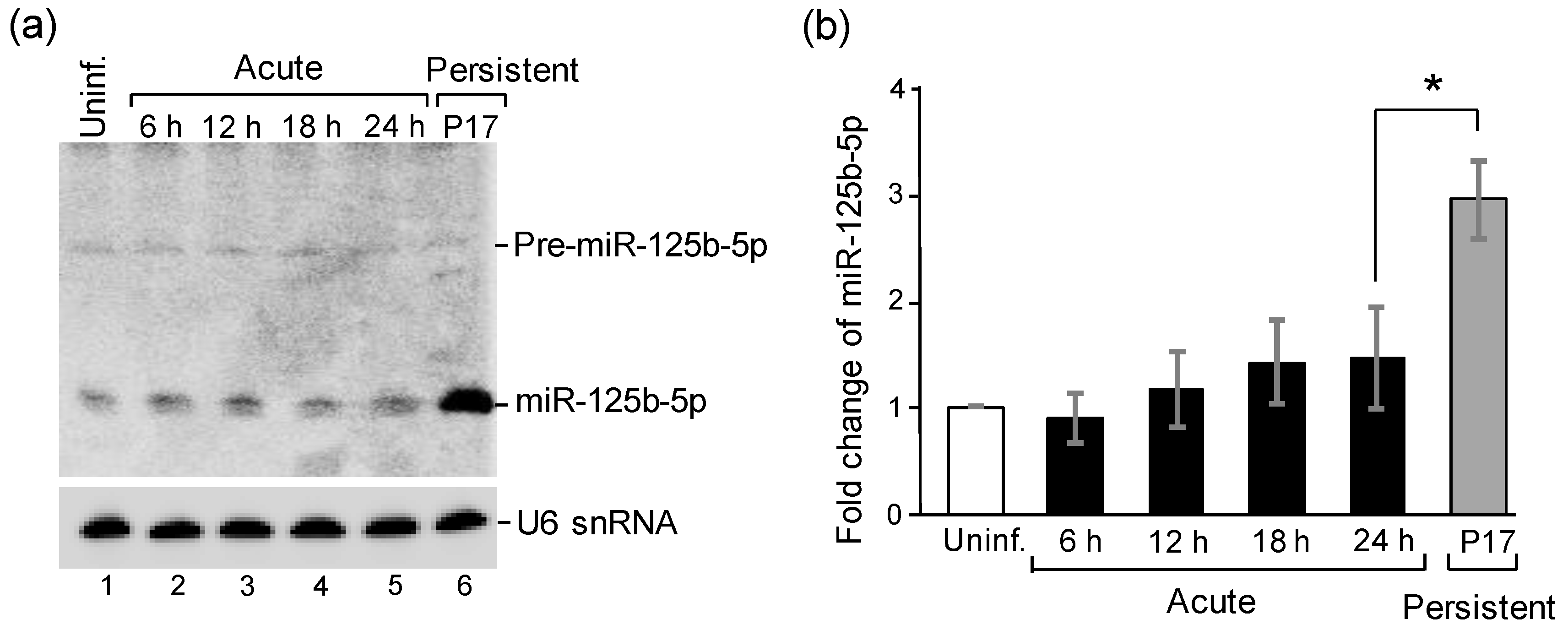
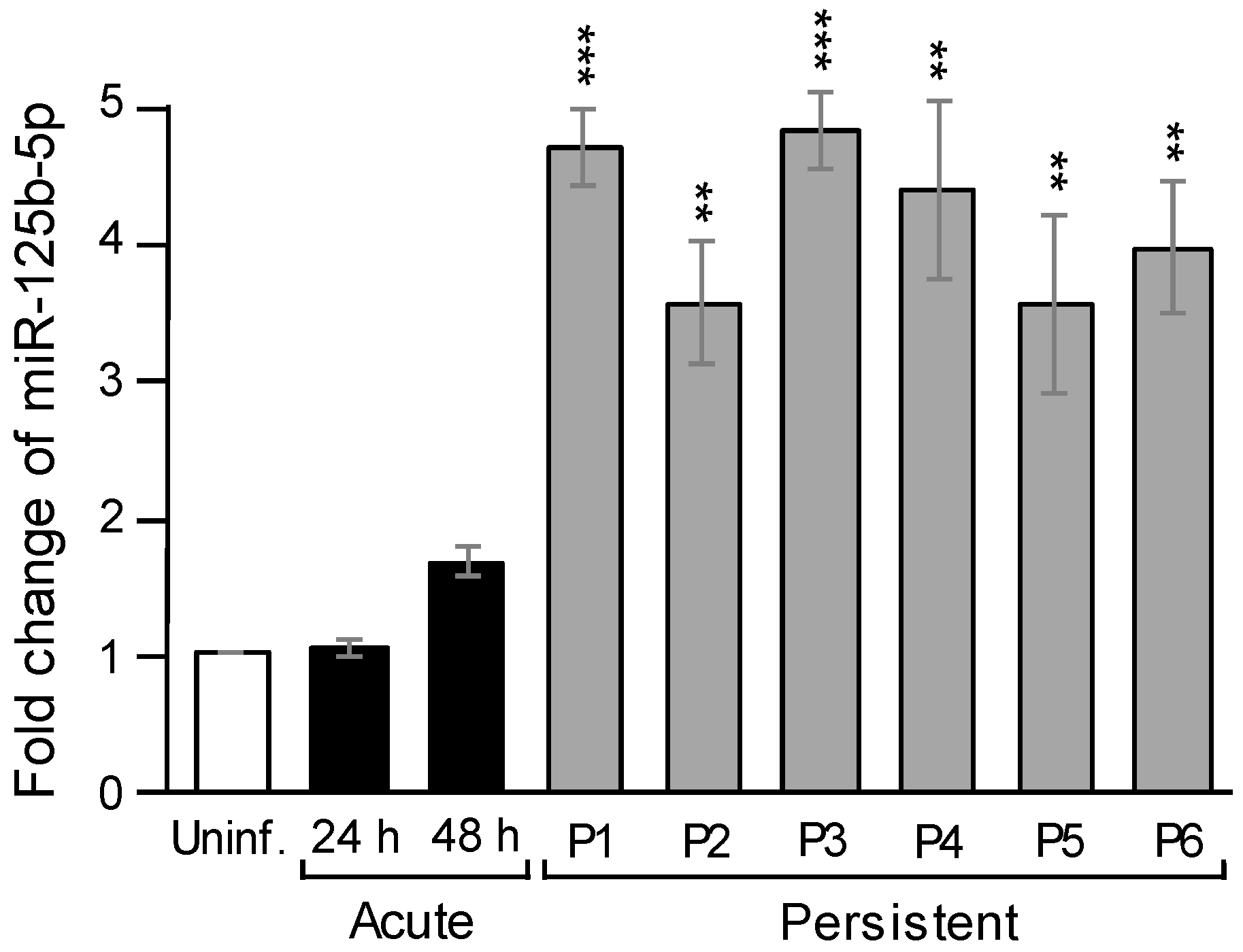

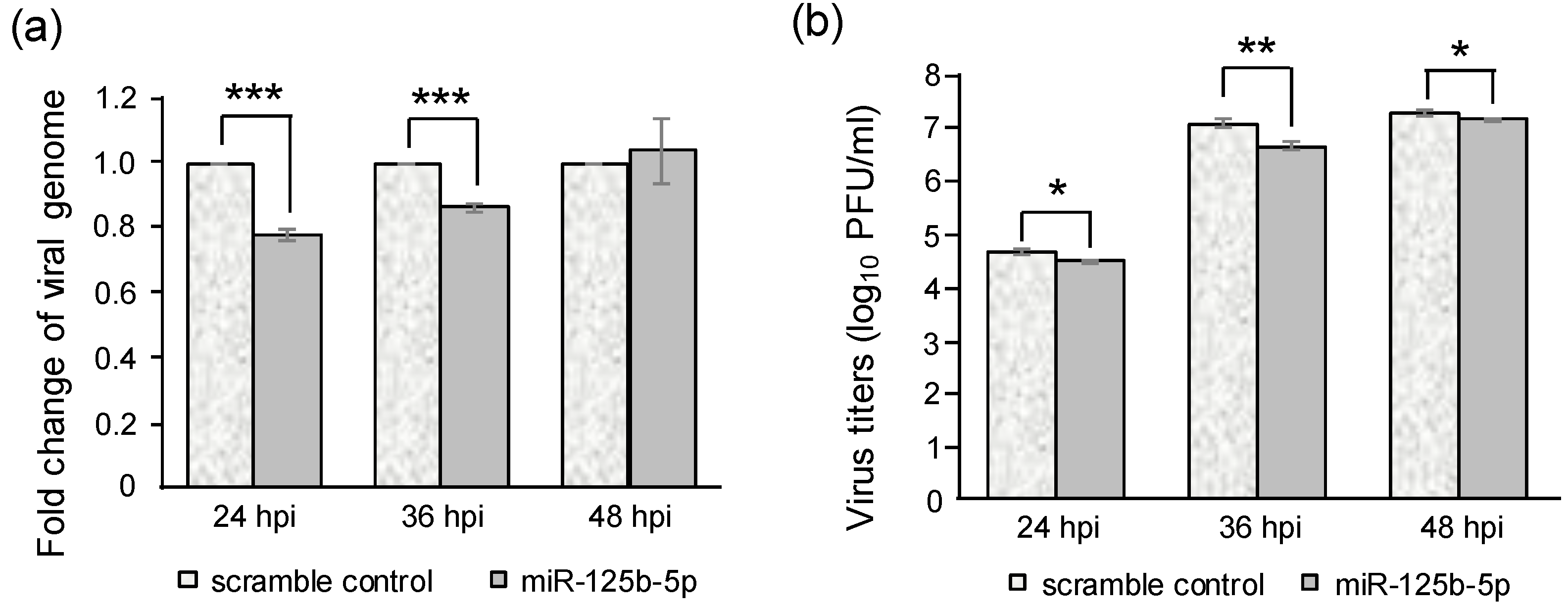
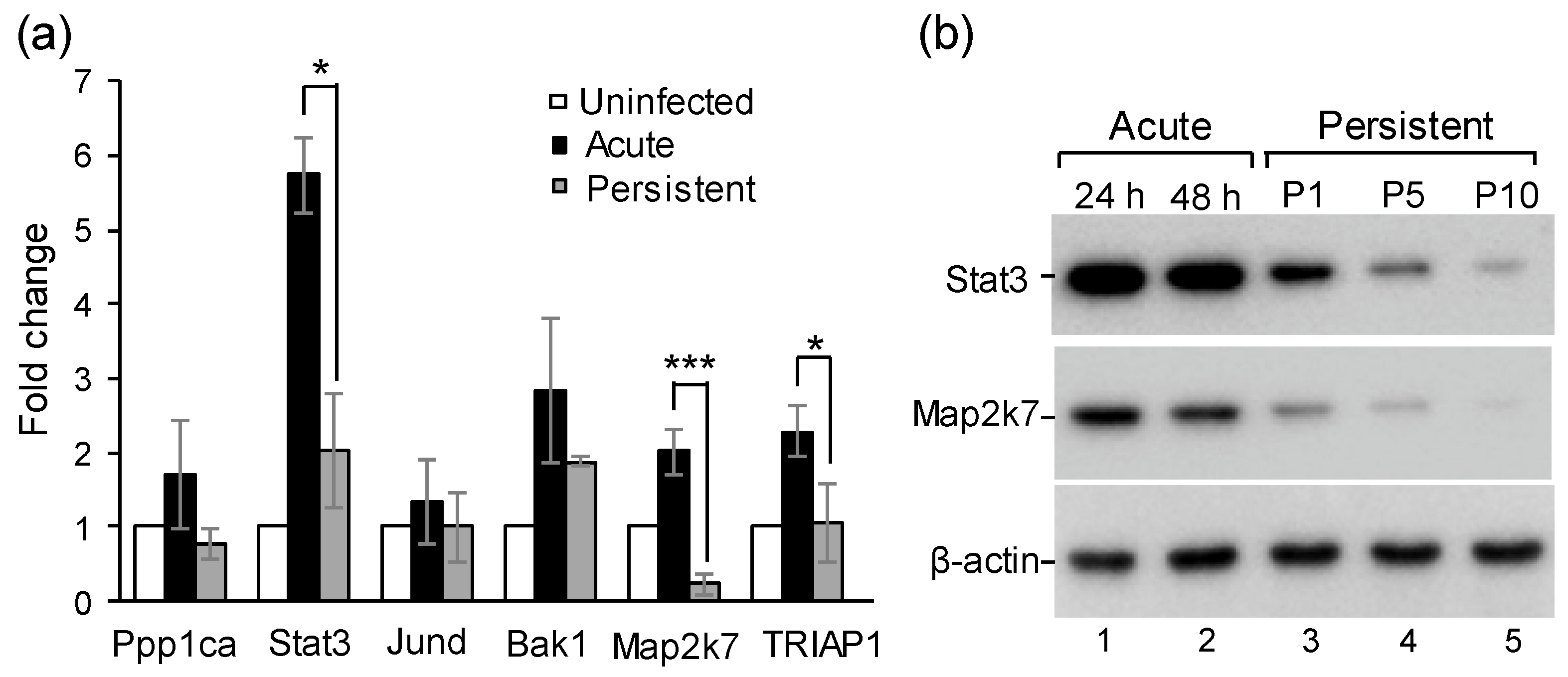
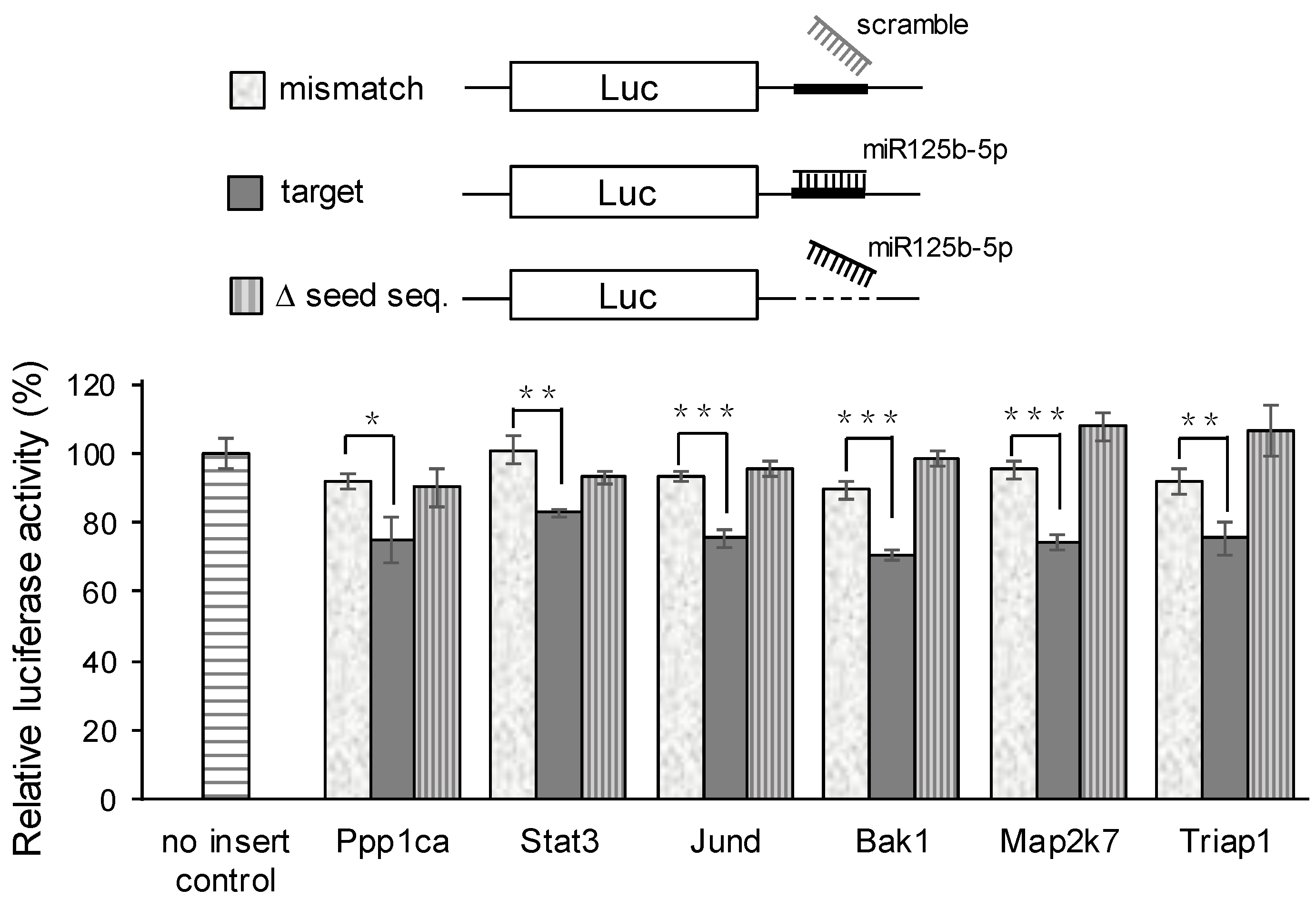

| miRNAs | Accession Number | Sequence (5′–3′) | A 1 | P 2 | P/A |
|---|---|---|---|---|---|
| Upregulated 3 | |||||
| mmu-miR-125b-5p | MIMAT0000136 | UCCCUGAGACCCUAACUUGUGA | 0.03 | 3.91 | 3.88 |
| mmu-miR-181a | MIMAT0000210 | AACAUUCAACGCUGUCGGUGAGU | 0.46 | 3.09 | 2.63 |
| mmu-miR-30a | MIMAT0000128 | UGUAAACAUCCUCGACUGGAAG | 0.84 | 3.13 | 2.29 |
| mmu-miR-34a | MIMAT0000542 | UGGCAGUGUCUUAGCUGGUUGU | 0.11 | 2.24 | 2.13 |
| mmu-miR-100 | MIMAT0000655 | AACCCGUAGAUCCGAACUUGUG | −0.35 | 1.76 | 2.11 |
| mmu-miR-140 | MIMAT0000151 | CAGUGGUUUUACCCUAUGGUAG | 0.02 | 1.66 | 1.64 |
| mmu-miR-2135 | MIMAT00000744 | UGAGGUAGUAGGUUGUGUGGUU | 0.75 | 2.36 | 1.61 |
| mmu-miR-804 | MIMAT0004210 | UGUGAGUUGUUCCUCACCUGGA | 0.28 | 1.77 | 1.49 |
| mmu-miR-425 | MIMAT0004750 | AAUGACACGAUCACUCCCGUUGA | −1.02 | 0.45 | 1.47 |
| mmu-miR-708 | MIMAT0004828 | AAGGAGCUUACAAUCUAGCUGGG | 0.76 | 2.15 | 1.39 |
| mmu-miR-532-5p | MIMAT0002889 | CAUGCCUUGAGUGUAGGACCGU | 0.34 | 1.72 | 1.38 |
| mmu-miR-194 | MIMAT0000224 | UGUAACAGCAACUCCAUGUGGA | −1.10 | 0.24 | 1.34 |
| mmu-miR-210 | MIMAT0017052 | AGCCACUGCCCACCGCACACUG | −1.28 | −0.09 | 1.19 |
| mmu-miR-30e | MIMAT0000248 | UGUAAACAUCCUUGACUGGAAG | 1.16 | 2.26 | 1.10 |
| Downregulated 4 | |||||
| mmu-miR-367 | MIMAT0017214 | ACUGUUGCUAACAUGCAACUC | 1.72 | 0.63 | −1.09 |
| mmu-miR-214 | MIMAT0004664 | UGCCUGUCUACACUUGCUGUGC | −1.23 | −2.34 | −1.11 |
| mmu-miR-202-5p | MIMAT0004546 | UUCCUAUGCAUAUACUUCUUU | 2.51 | 1.33 | −1.18 |
| mmu-miR-376a | MIMAT0003387 | GGUAGAUUCUCCUUCUAUGAGU | 1.21 | −0.01 | −1.22 |
| mmu-miR-2133 | MIMAT0000738 | UUAAUAUCGGACAACCAUUGU | 5.06 | 3.64 | −1.42 |
| mmu-miR-34b-3p | MIMAT0004581 | AAUCACUAACUCCACUGCCAUC | 0.32 | −1.26 | −1.58 |
| mmu-miR-338-3p | MIMAT0000582 | UCCAGCAUCAGUGAUUUUGUUG | 1.49 | −0.13 | −1.62 |
| mmu-miR-361 | MIMAT0000704 | UUAUCAGAAUCUCCAGGGGUAC | 0.01 | −1.67 | −1.68 |
| mmu-miR-208b | MIMAT0017280 | AAGCUUUUUGCUCGCGUUAUGU | 0.59 | −1.13 | −1.72 |
| mmu-miR-132 | MIMAT0016984 | AACCGUGGCUUUCGAUUGUUAC | −0.48 | −2.22 | −1.74 |
| mmu-miR-15b | MIMAT0000124 | UAGCAGCACAUCAUGGUUUACA | 0.25 | −1.52 | −1.77 |
| mmu-miR-2140 | MIMAT0000753 | ACAGUAGAGGGAGGAAUCGCAG | 3.23 | 1.38 | −1.85 |
| mmu-miR-31 | MIMAT0000538 | AGGCAAGAUGCUGGCAUAGCUG | 0.03 | −2.07 | −2.10 |
| mmu-miR-490 | MIMAT0017261 | CCAUGGAUCUCCAGGUGGGU | 0.58 | −1.63 | −2.21 |
| mmu-miR-125a-3p | MIMAT0004528 | ACAGGUGAGGUUCUUGGGAGCC | 0.20 | −2.45 | −2.65 |
| mmu-miR-1224 | MIMAT0005460 | GUGAGGACUGGGGAGGUGGAG | 2.98 | 0.30 | −2.68 |
| mmu-miR-128 | MIMAT0000140 | UCACAGUGAACCGGUCUCUUU | 0.60 | −2.25 | −2.85 |
Publisher’s Note: MDPI stays neutral with regard to jurisdictional claims in published maps and institutional affiliations. |
© 2021 by the authors. Licensee MDPI, Basel, Switzerland. This article is an open access article distributed under the terms and conditions of the Creative Commons Attribution (CC BY) license (https://creativecommons.org/licenses/by/4.0/).
Share and Cite
Huang, C.-W.; Tsai, K.-N.; Chen, Y.-S.; Chang, R.-Y. Differential miRNA Expression Profiling Reveals Correlation of miR125b-5p with Persistent Infection of Japanese Encephalitis Virus. Int. J. Mol. Sci. 2021, 22, 4218. https://doi.org/10.3390/ijms22084218
Huang C-W, Tsai K-N, Chen Y-S, Chang R-Y. Differential miRNA Expression Profiling Reveals Correlation of miR125b-5p with Persistent Infection of Japanese Encephalitis Virus. International Journal of Molecular Sciences. 2021; 22(8):4218. https://doi.org/10.3390/ijms22084218
Chicago/Turabian StyleHuang, Chih-Wei, Kuen-Nan Tsai, Yi-Shiuan Chen, and Ruey-Yi Chang. 2021. "Differential miRNA Expression Profiling Reveals Correlation of miR125b-5p with Persistent Infection of Japanese Encephalitis Virus" International Journal of Molecular Sciences 22, no. 8: 4218. https://doi.org/10.3390/ijms22084218
APA StyleHuang, C.-W., Tsai, K.-N., Chen, Y.-S., & Chang, R.-Y. (2021). Differential miRNA Expression Profiling Reveals Correlation of miR125b-5p with Persistent Infection of Japanese Encephalitis Virus. International Journal of Molecular Sciences, 22(8), 4218. https://doi.org/10.3390/ijms22084218






